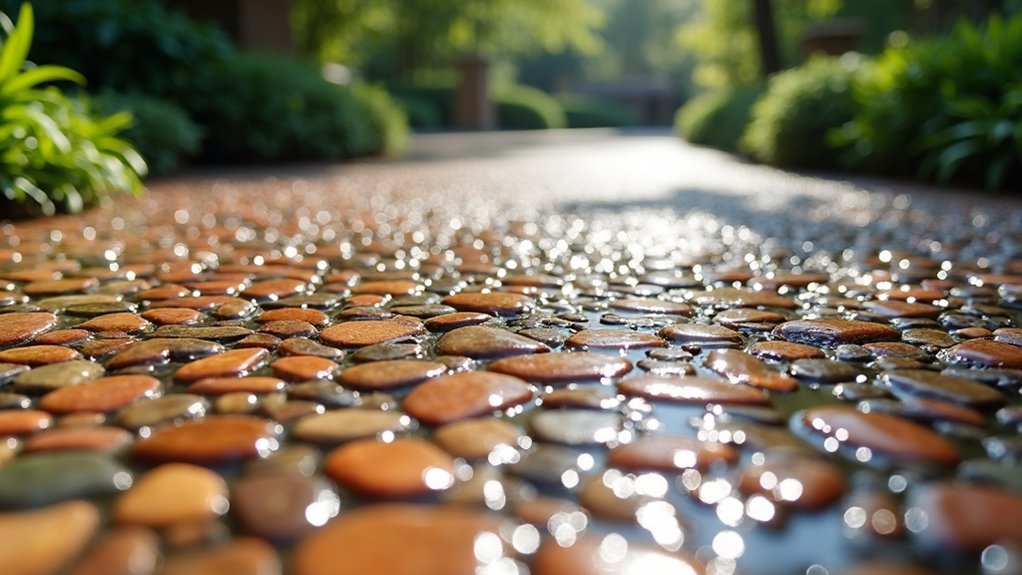Resin-bound gravel sorts out water puddling on driveways by letting water drain straight through its surface – about 95% of it, in fact. Think of it like a giant sieve: the mix of carefully chosen angular stones and proper foundation layers spreads the weight evenly and stops cracks forming. Getting the slope right during installation is crucial too, as it helps guide rainwater away properly. Much like a well-built patio, these features work together to keep your driveway puddle-free and lasting longer.
Key Takeaways
Resin-bound gravel sorts your driveway’s puddle problems brilliantly. These surfaces shift nearly all surface water – we’re talking about 95% – straight through the material.
Think of it like a coffee filter: small gaps between the stones let water pass naturally, rather than collecting on top. Much better than watching your car splash through miniature lakes every morning.
The key’s in proper installation. A solid sub-base spreads weight evenly (no more annoying dips where water collects), and a slight 1:60 slope – about the same as a gentle ramp – guides rain away from your house.
To keep it working properly, just sweep away leaves and pull any weeds that pop up. Dead simple maintenance that keeps your driveway puddle-free year-round.
Understanding Permeability in Resin-Bound Gravel
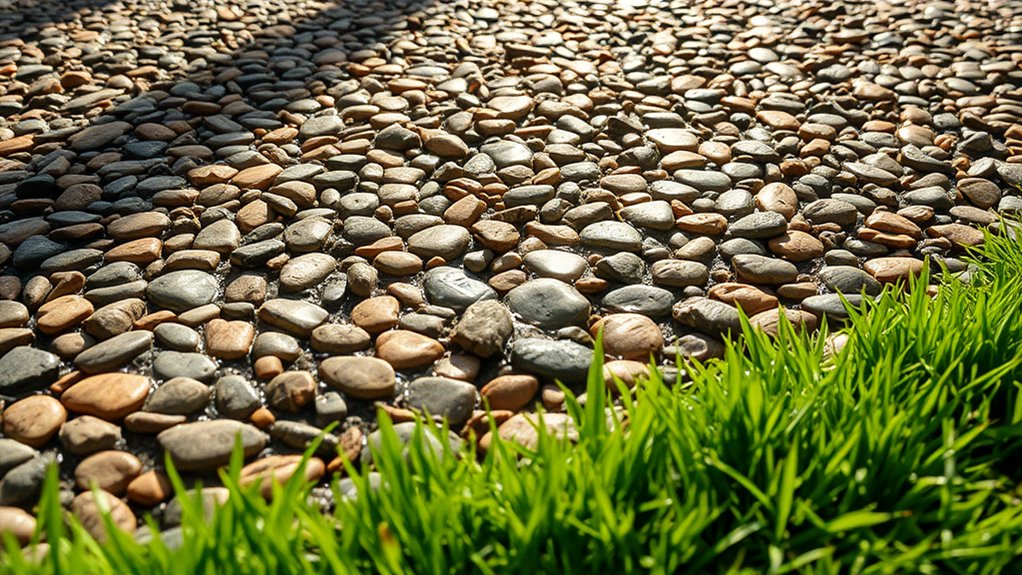
Water permeability is crucial for resin-bound gravel surfaces across UK towns and cities. Much like a household tea strainer, the tiny gaps between stones allow rainwater to filter through naturally. A well-installed system can drain up to 95% of surface water, though this depends on proper ground preparation and resin mixture. The system’s effectiveness relies on several factors: the quality of the subgrade beneath, how well the resin-bound layer is compacted, and the right balance of resin to stone. Think of it as laying a proper foundation for your house – get it wrong, and you’ll face problems later. Additionally, the permeability rates of resin-bound surfaces can significantly help support local drainage systems.
Regular upkeep is essential – just hoovering the surface now and then keeps it free from leaves and grit that might block the drainage. Notably, these surfaces also support Sustainable Urban Drainage Systems(SuDS) that help manage rainfall effectively.
When done properly, resin-bound gravel helps tackle common British weather challenges like puddles and localised flooding, particularly useful given our rainy climate.
The Role of Aggregate Selection
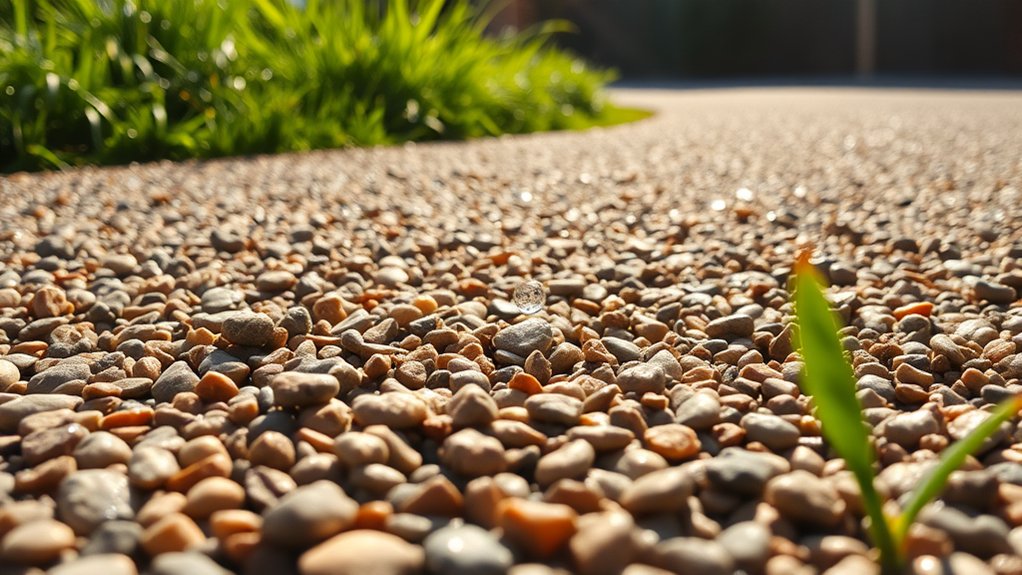
The Role of Aggregate Selection
Selecting the right aggregates proves crucial for effective resin-bound gravel surfaces and proper water management. The correct choice directly affects both performance and drainage. Angular aggregates of 2-5mm work best for water flow, whilst washed and kiln-dried materials prevent damp-related problems. Essential aggregate characteristics include:
| Aggregate Type | Benefits | Impact on Drainage |
|---|---|---|
| Angular (2-5mm) | Improves grip, facilitates water flow | Reduces puddling |
| Washed & Kiln-Dried | Minimises dust, enhances permeability | Maintains drainage |
| Rough Texture | Increases friction, reduces slip risk | Maintains water flow |
| Consistent Grading | Prevents fines build-up | Enhances drainage efficiency |
| Durable Outdoor Use | Resists weathering, ensures longevity | Maintains permeability |
Sound aggregate selection remains vital for optimal results. Incorporating suitable drainage channels ensures that water can effectively flow away from the surface, further preventing any potential puddling issues. Moreover, using washed and kiln-dried aggregates helps create a stronger bond with the resin, ensuring long-lasting durability and performance.
Installation Process and Its Impact on Drainage

During installation, a well-prepared base is crucial for proper drainage. The base must be solid and spotlessly clean to ensure the resin bonds properly and water drains away effectively. Additionally, it’s important to ensure concrete/tarmac base is strong enough for intended use to prevent future issues. The curing process requires careful timing – work swiftly to maintain the surface’s permeability and avoid any early setting. In particular, the 1-2% slope should be considered to facilitate effective rainwater runoff. Think of it like laying a patio: if the groundwork isn’t level and properly prepared, you’ll end up with puddles after every rainfall.
Proper Base Preparation
Proper base preparation for resin-bound gravel starts with good drainage to stop water pooling and surface damage.
First, dig out the area to the right depth and check the natural slope. After clearing soil and debris, fit drainage channels where needed.
Lay a geotextile membrane to keep the base stable and block weeds. Add and compact MOT Type 1 aggregate (crushed stone) evenly – much like creating a solid foundation for a garden shed.
Fix edge restraints to hold the resin in place, and check it’s level everywhere, just as you’d with a patio. Sort out any dips where water might collect.
Getting this groundwork right means your new driveway will drain properly and last for years.
Curing Time Importance
Curing time plays a vital role in getting resin-bound gravel driveways right. Most installations need 24 to 48 hours to cure properly, though this varies with the weather.
Summer warmth speeds things up, whilst cold, damp conditions slow it down.
Getting the curing process spot-on ensures the resin binds properly with the stones, keeping the surface porous for good drainage.
Rush this step, and you’ll risk surface damage and puddles forming where water can’t drain away.
In cold weather, curing accelerators can help, but they must be applied evenly.
Get this wrong, and you’ll end up with an uneven surface that doesn’t drain properly.
Simply put, waiting the right amount of time before using your new driveway will save you from costly repairs down the line.
Think of it like waiting for paint to dry – rush it, and you’ll spoil the finish.
Importance of a Quality Sub-Base
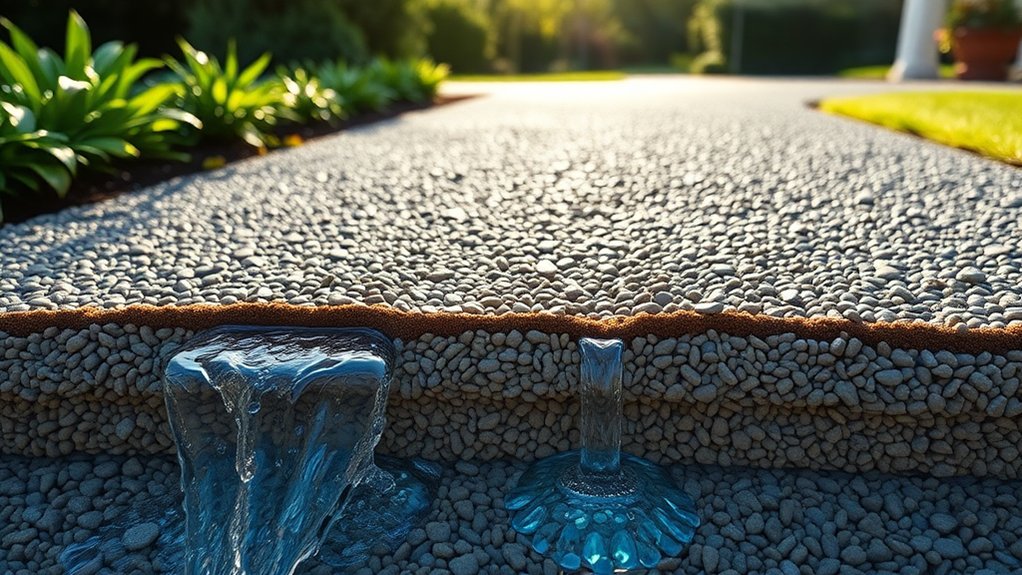
A quality sub-base forms the backbone of any resin-bound gravel surface and directly impacts its longevity.
The right sub-base delivers these key benefits:
- Spreads weight evenly across the surface, stopping cracks and dips
- Creates a solid foundation for the base course, much like a house needs proper foundations
- Prevents ground failure, especially during Britain’s wet weather
MOT Type 3 aggregate is the go-to choice for UK installations, offering excellent drainage and strength.
Think of it as the groundwork for your entire driveway – get this right, and you’ll avoid common issues like puddles and surface damage. Proper installation and thorough compaction are crucial steps that shouldn’t be rushed.
A solid sub-base isn’t just about immediate stability – it’s an investment that protects your driveway for years to come whilst ensuring proper water drainage, particularly important for our British climate.
Comparing Resin-Bound Gravel to Traditional Materials
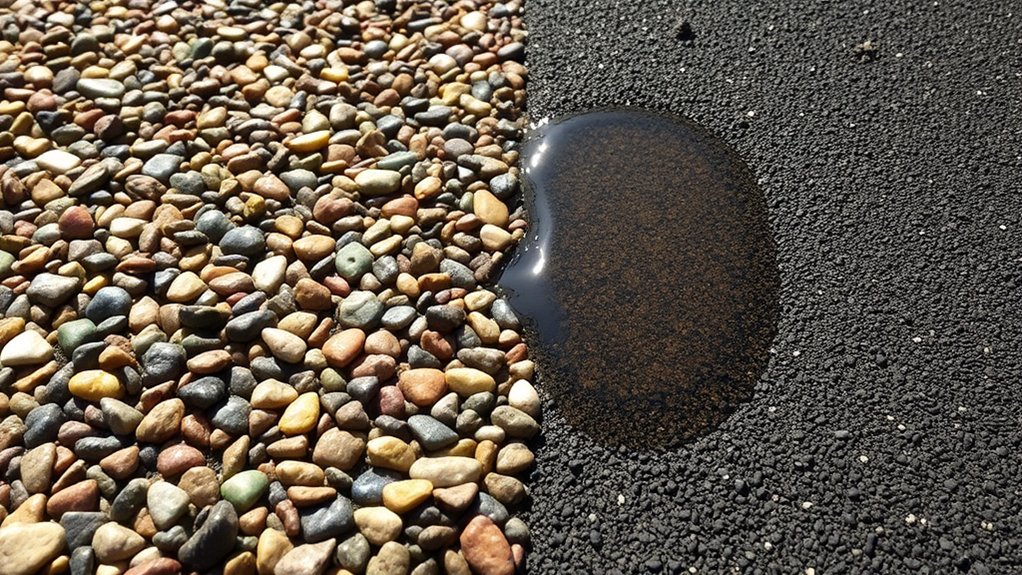
Resin-bound gravel outperforms traditional materials in several key areas. The surface offers a sleek, contemporary finish with various colour options, whilst loose gravel tends to scatter and look messy.
Think of the difference between a well-kept garden path and one that’s spread across the lawn – that’s the level of tidiness you’ll get with resin-bound.
These surfaces last 15-20 years with minimal upkeep, unlike concrete which often cracks in British weather.
Though pricier upfront compared to loose gravel, resin-bound surfaces cost about the same as quality block paving. For a typical driveway or garden path, you’re investing in something that won’t need constant raking or topping up.
The stability means no loose stones under foot or stuck in car tyres – particularly useful for pushchairs, wheelchairs and high heels.
It’s permeable too, helping prevent puddles during our frequent rain.
Simply put, resin-bound gravel offers better long-term value and practicality than traditional options.
Environmental Benefits of Resin-Bound Surfaces
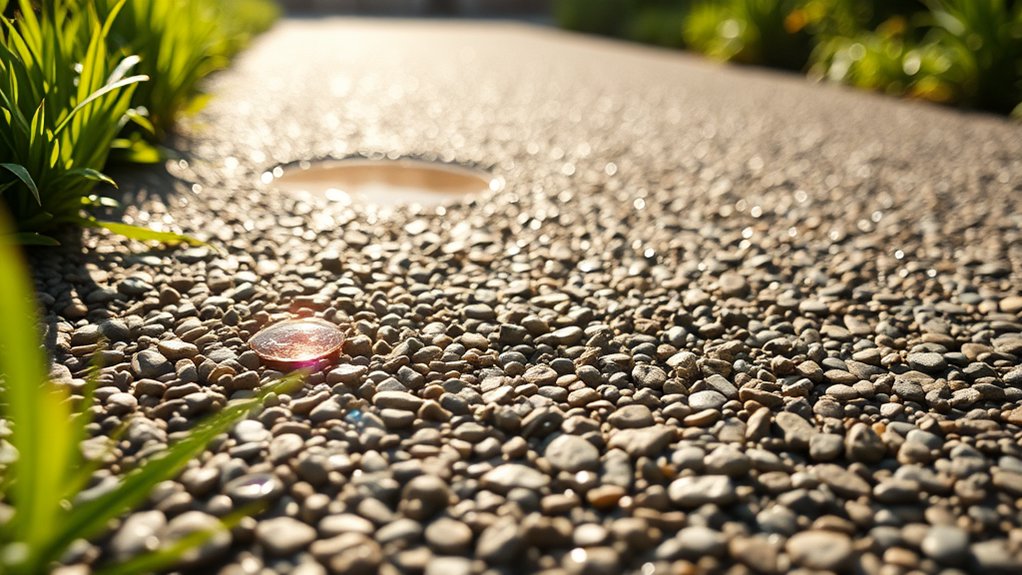
Environmental Benefits of Resin-Bound Surfaces
Resin-bound surfaces offer key environmental advantages for UK properties, particularly in our rainy climate. These surfaces help manage water whilst supporting local wildlife and plant life.
Main benefits:
- Water Management: Naturally drains rainfall into the ground, reducing puddles and surface flooding common to British gardens and driveways.
- Pollution Control: Acts as a natural filter for rainwater, removing harmful substances before they reach local streams and rivers.
- Wildlife Support: Creates spaces where garden insects can thrive and helps maintain soil moisture for nearby plants and trees.
These practical surfaces work particularly well in urban areas where concrete and tarmac typically cause drainage issues.
They’re especially useful for front gardens, driveways and patios where water management is crucial during heavy British downpours.
Preventing Water Pooling During Installation
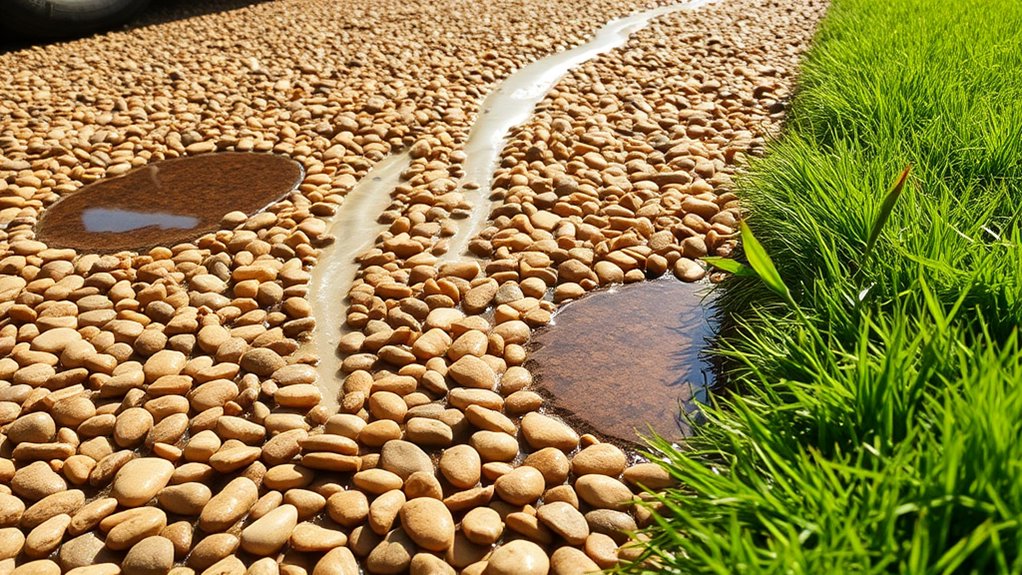
Proper drainage is essential when laying surfaces to avoid water pooling.
Start with a robust sub-base – think of it like building a house’s foundation. Create a gentle slope of roughly 1:60 (about 1.5 degrees) away from buildings or structures.
A well-compacted base using Type 1 MOT or similar aggregate works brilliantly. Let each layer set properly; rushing the job typically leads to drainage issues down the line.
Importance of Sub-Base
The Importance of Sub-Base
A proper sub-base forms the backbone of any resin-bound surface, preventing water pooling and ensuring long-term stability. The right materials and thickness directly impact drainage and performance:
Material Selection
Standard MOT Type 1 works brilliantly for everyday paths and driveways, whilst MOT Type 3 suits projects requiring sustainable drainage systems (SuDS).
Drainage Efficiency
Good sub-base design means rainwater drains away properly – no more puddles or waterlogging to worry about.
Load-Bearing Capacity
The sub-base must handle expected weight loads, whether it’s foot traffic on garden paths or vehicles on driveways.
Getting this right prevents sinking and cracking later on.
Proper Sloping Techniques
Proper slopes are essential for resin-bound gravel surfaces to prevent water pooling and ensure good drainage. For best results, maintain a gradient between 1:12 and 1:40 – think of it as a gentle ramp rather than a steep hill.
Start laying from the slope’s bottom to stop materials sliding downwards. Much like a garden path, you’ll want to include proper drainage channels to direct water away efficiently. Sharp-edged stones work best, as they grip better on slopes (similar to winter car tyres).
Check your surface regularly for any loose patches or puddles, especially after heavy rain. Sort these issues quickly to keep your driveway in top condition. Think of it as giving your car an MOT – catching problems early saves hassle later.
Following these guidelines will give you a practical, safe surface that lasts for years.
Curing Time Considerations
Curing Time Considerations
Proper sloping sets up essential drainage, whilst the curing process ensures your resin-bound gravel handles British weather without water pooling. The curing timeline varies with temperature – much like waiting for paint to dry on a damp day.
Key curing periods:
- 6-8 hours for initial set (safe for walking)
- 24-36 hours for full cure (ready for vehicles)
- Double these times in cold or damp conditions
Keep rain off during curing – rather like protecting fresh concrete from a downpour.
A properly cured surface creates a water-permeable layer that prevents puddles and maintains its shape.
Getting the curing right means your driveway will last for years to come.
Long-Term Maintenance for Optimal Performance
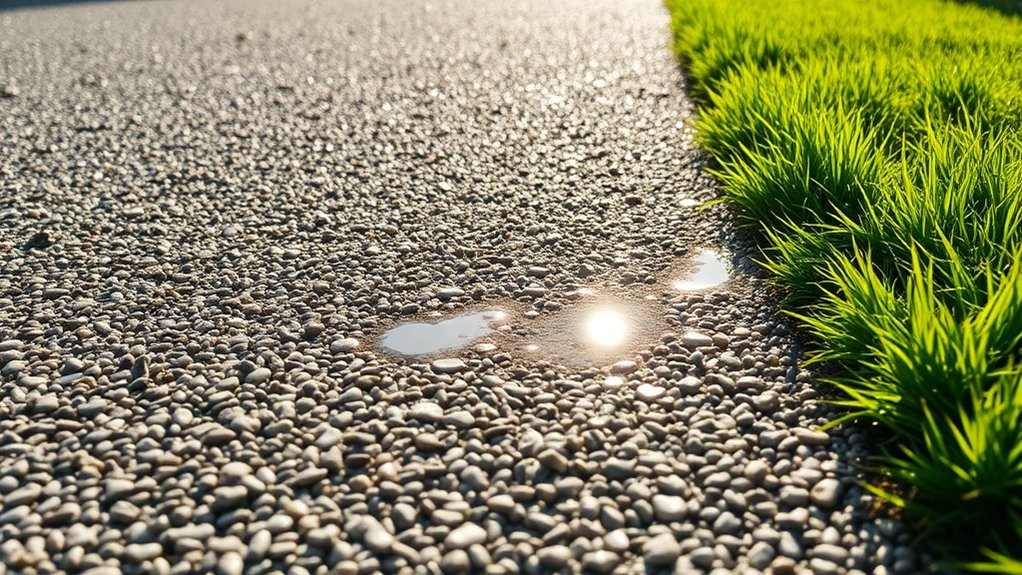
Regular maintenance keeps resin-bound driveways performing at their best.
Clean your driveway every few months by sweeping off loose debris and scrubbing with mild detergent and a soft brush.
For common problems, use household solutions – cat litter works brilliantly on oil spills, whilst white vinegar tackles algae effectively.
When pressure washing, keep the setting low to avoid damaging the resin.
Though these surfaces naturally resist weeds, it’s worth checking for any growth and removing them by hand or with suitable weed killer.
Simple, consistent care will keep your driveway looking smart and working properly for years.
Regulatory Compliance and Sustainable Urban Planning
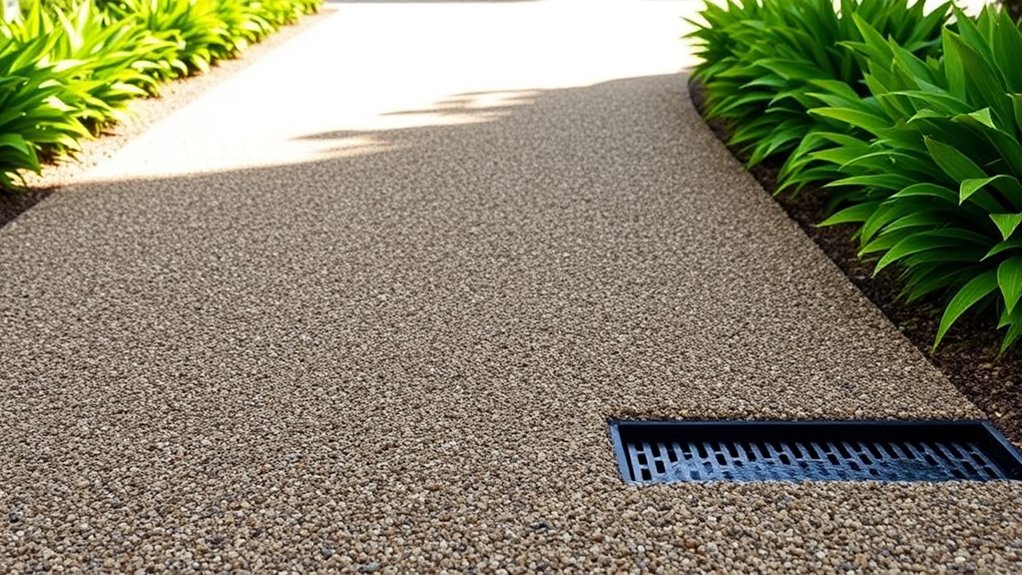
Resin-bound gravel driveways offer a practical solution to today’s urban drainage challenges whilst meeting UK planning regulations.
These surfaces tick all the boxes for Sustainable Urban Drainage Systems (SUDS) requirements, making them increasingly popular with local councils and homeowners alike.
Key benefits:
- No planning permission needed, as the permeable surface complies with current regulations
- Natural drainage that works like normal ground, cutting flood risks on your property
- Built-in filtering system that catches pollutants before they reach the water table
For UK homeowners facing strict planning rules, particularly in new-build areas or conservation zones, these driveways provide a straightforward way to comply with local authority requirements whilst maintaining an attractive driveway surface.
Frequently Asked Questions
How Does Weather Impact Resin-Bound Gravel’s Performance?
Weather significantly affects resin-bound gravel surfaces across the UK. Cold winter temperatures slow down curing times, whilst high humidity can weaken the bond between resin and stone. These conditions may impact both the initial installation and long-term durability of your driveway or path.
Can Resin-Bound Gravel Be Repaired if Damaged?
Yes, resin-bound gravel surfaces can be repaired when damaged. Small cracks and chips can be fixed by applying matching resin and aggregate mix to the affected area, whilst larger damaged sections might need cutting out and replacing. Best results come from having repairs done by professional installers who can properly match the original materials and colour.
What Colors Are Available for Resin-Bound Surfaces?
Resin-bound surfaces come in a wide range of colours, from natural browns and tans to modern greys and creams. Popular choices include earthy tones that match traditional British garden settings, whilst contemporary options like charcoal and silver-grey suit urban properties. Whether you’re matching your home’s brickwork or creating contrast with existing landscaping, there’s a shade to fit every outdoor space.
Is Resin-Bound Gravel Suitable for Heavy Vehicle Traffic?
Resin-bound gravel can handle heavy vehicles when properly installed. Much like a well-built car park surface, it offers robust support for lorries and large commercial vehicles. The system’s strength comes from its precise mixture of aggregate and resin, creating a stable surface that resists cracking under substantial weight.
How Does Resin-Bound Gravel Compare to Permeable Concrete?
Resin-bound gravel and permeable concrete each handle water drainage differently. Resin-bound surfaces can be laid directly onto existing hard surfaces, making them a popular choice for UK driveways and paths. Permeable concrete, whilst equally effective at managing rainfall, needs more thorough ground preparation and a proper sub-base to function properly. Both options help reduce surface water and comply with UK planning regulations for sustainable drainage systems (SuDS).
Conclusion
The bottom line: resin-bound gravel stands out as a practical choice for British driveways, tackling our common problem of puddles and surface water. It’s permeable, which means rainwater drains away naturally rather than collecting in pools. When fitted properly with suitable stones and maintained regularly, it provides lasting performance whilst meeting local planning requirements. For UK homeowners seeking a low-maintenance, environmentally sound driveway that looks smart, resin-bound gravel ticks all the boxes.
